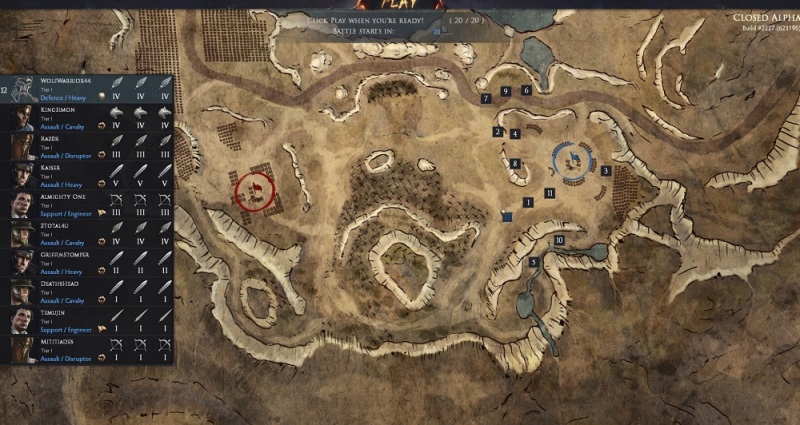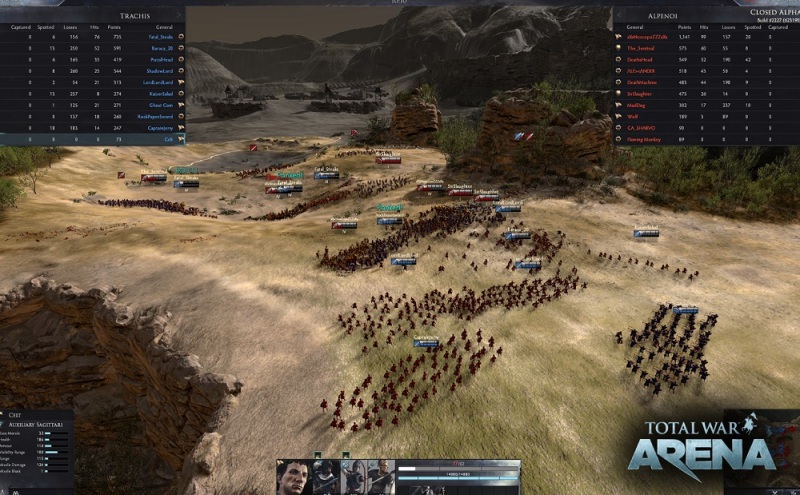Sega’s The Creative Assembly studio is launching a closed beta test for Total War: Arena, a multiplayer-only game where ten players can take on ten in a massive ancient battle with thousands of soldiers.
The free-to-play PC online game is part of the Total War: Rome II franchise that debuted in 2013 and Total War: Attila that came out in January. I played the latter for more than 400 hours, as it was quite addictive. I had a hands-on preview of the Total War: Arena game with developers James Given, community coordinator at Creative Assembly, and Leif Burrows, map designer. The U.S. closed beta test is starting this week.
Total War: Arena is an extension of the Total War brand into a multiplayer battle experience, and it reflects the influence of Riot Games’ League of Legends. Past Total War releases featured just four-on-four online matches. Total War: Arena will let 10 players on each side control a full company of soldiers.
That may seem like it’s really hard to pull off. But since so many players fall out of a game on the Internet, 10 versus 10 is sustainable, since the loss of one player isn’t that big a deal. The matches are also limited to just 15 minutes each.
The choices aren’t that plentiful yet, but The Creative Assembly will add to them over time. At the moment, there are seven commanders available so far: three for Rome, three for Greece, and one for the barbarians. You choose your commander and then pick your troops. Over time, you can upgrade your commander’s abilities and upgrade your troops along an elaborate quality ladder.
Arena uses the Total War: Rome II engine, which can place thousands of soldiers on a battlefield. You command groups of them and can zoom in on individual soldiers or zoom out for a bird’s-eye view of the 3D battlefield. In this case, players controlling Greek or Roman soldiers will be able to square off against each other on a sizable battleground with lots of strategic control points.
You command about three companies of soldiers in Total War: Arena. With 10 players, you still wind up with 7,000 or 8,000 soldiers on a map. But each company can behave in a more realistic way because it will be more closely managed by a single player. Consequently, each battle will have much more intelligent and strategic thinking — so long as the players cooperate closely.
Each player becomes an iconic commander from history (Alexander the Great, Germanicus, Caesar, Leonidas, and others) with a unique battle style. That commander controls three units of warriors. Players can level up their commanders and units, and they can attain specialist skills, weaponry, armor, and abilities.
I played three hands-on matches so far. I started with Germanicus, a Roman general, with some low-level tier-one soldiers (out of a total rank of 10 at the top). When the match starts, you see portraits of all the commanders. You can mix and match different nations on your side. So it’s not exactly realistic, but you get to choose who you want to play. You also choose one of ten starting positions on the map. You can be left, center, or right, and in the front ranks or in the back.
I had light units and archers. The archers stayed in back. The javelin soldiers were also positioned behind the sword infantry. You try to pin the enemy with swords and then hit them with ranged attacks via javelins and archers. That was the plan, anyway. I used the mouse to change my point of view so I could get the best view of my troops.
When the battle started, we were positioned on a hill. A watch tower lay ahead. I started marching for it. Watch towers are important because they give your troops a wider view of the battlefield. That lets you spot enemy troop concentrations and discover enemy ambushes. The game has no “fatigue,” as the matches are so short.
“To add fatigue would really slow the game down,” Given said.
I marched my troops at the the tower, but as soon as we got close, we spotted a bunch of enemy soldiers. They charged my three companies, and I charged. They had me outnumbered about three-to-one. I had no fellow troops in sight. So I tried to pull back, but the enemy quickly mauled my units and they routed, which means they started running away out of control. This happened in about a course of a minute. I didn’t pay attention, but obviously the enemy had better front-line soldiers, and they also had help from archers.
I managed to retreat and then just pulled back. But I ultimately lost all my units. I pulled out of the game and prepared to start another. But I later learned we actually won. My team had the enemy outnumbered, just not where I was. There were separate micro battles within the larger battle.
In another battle, we played on the Germania map, which was a large map with forests and roads cutting through it. I was a little more cautious moving forward this time. For a while, I moved forward, and I couldn’t find the enemy.
Finally, I started attacking the enemy’s wooden fort. My sword soldiers attacked the gate. My archers hit the enemy on the wall. We broke through into the enemy camp, but then we discovered the enemy had stealthily moved around the edge and took our undefended camp.
“This encourages a different kinds of strategy,” Burrows said.
At least my units did well, and I was able to upgrade them after the battle. I spent some silver, which I gained from playing. The commander had to be upgraded before I could get better units.
And in the last battle, my side was on one side of the river, and the enemy was on the other. They had a big hill on their side and a bunch of grass that obstructed views. I had some barbarian cavalry, and I picked a starting position on the right flank of the barbarian army. I sent my units across the river, through the grass. But the other side had visibility into the grass because they had a nearby watch tower.
My horse soldiers ran into an ambush led by spear infantry. In the rock-paper-scissors balance of the game, the spear infantry trump the horse soldiers in a head-on collision. They quickly tore through all of my units. I retreated across the river and was left with just a handful of soldiers.
I was virtually out of the match, but I stayed in the back so I could continue to watch. The fight was concentrated at the enemy base. But at some point, the running total of soldiers was clear. The enemy had twice as many soldiers as we did. They just kept grinding down my team in infantry clashes, reducing our units to virtually nothing. I sent my remaining horse soldiers across the river to take the watch tower, which the enemy had abandoned. But it made no difference. So we went down in defeat. Once again, the fight lasted no more than ten minutes.
Clearly, it makes a difference if you communicate across your team, even if it’s as simple as “fake left, attack on the right.” You can win by scoring higher, capturing the enemy base, or if the other side gives up.
“We are looking to add more features into team communication, as it’s not always obvious what is going on,” Given said.
The client PC will do most of the processing for the game, while the server infrastructure will handle things like your persistent commander records.
Titles in this series are perennial sellers, with new fans and history buffs playing them long after they’ve launched. Sega previously said that gamers play Total War titles for 104 hours per game.
The Total War series has been around for 14 years, and The Creative Assembly is now launching multiple offerings based on the same Total War brand. For instance, it recently launched Total War: Attila. All of that activity shows you just how big the Total War development effort has become, with more than 300 employees working at The Creative Assembly, which is based in Horsham, England.


